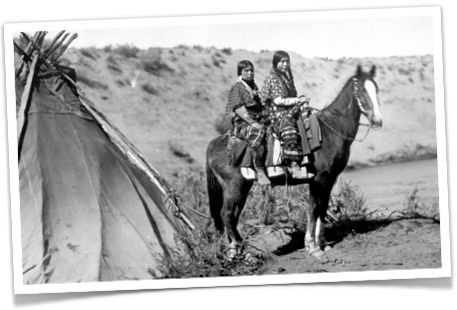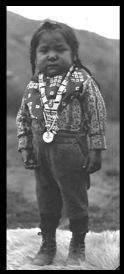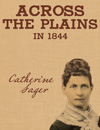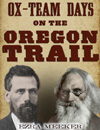Native Americans
On the Oregon Trail

RELATIONSHIPS
The first section of the Oregon Trail bisected two major Native American tribes--the Cheyenne to the north and the Pawnee to the south. The emigrants worried about both. But the expected attacks did not come. In fact, there were many instances of Native American kindness--helping pull out stuck wagons; rescuing drowning emigrants; even rounding up lost cattle.
Most of the encounters with Native Americans were simple business transactions. The emigrants offered clothes, tobacco or rifles, in exchange for Native American horses or food.
Within a few years, the emigrants had overgrazed the prairie grasses, burned all the available firewood, and depleted the buffalo. Soon many tribes along the Platte were impoverished.
The emigrants worried a great deal about possible Native American attacks, but very few were ever actually killed by the native tribes.
GRATTAN MASSACRE
Perhaps the most important confrontation with the native tribes occurred near Ft. Laramie in 1854, and became known as the Grattan Massacre. It began innocently enough--a single cow wandered away from an emigrant wagon train. When the cow showed up at a nearby Sioux village, the tribe promptly ate it. An aggressive Lt. Grattan and 28 men then left Fort Laramie with a single objective--punish the Sioux. The Sioux recognized their error and offered a horse in return for the cow, but Grattan wasn't interested. He ordered his men to fire on the tribe.
The Sioux chief told his warriors to withhold retaliation. Grattan fired again and killed the chief. Strikes and counterstrikes escalated into all-out war--the battles continued for decades.
MASSACRE ROCKS INCIDENT
For years, the Hudson's Bay Company had been a stabilizing force on the Native Americans who lived near the Snake River--but when the British fur-trading company pulled out in the early 1850s, attacks on emigrants increased substantially.
 The best-known incident happened near Massacre Rocks in what is now Southern Idaho. On August 9th, 1862 the attack came without warning. Within minutes, five emigrants were dead. The next morning the survivors regrouped and fought back.
The best-known incident happened near Massacre Rocks in what is now Southern Idaho. On August 9th, 1862 the attack came without warning. Within minutes, five emigrants were dead. The next morning the survivors regrouped and fought back.
Emigrant John Hilman:
"Thirty men went in pursuit of the Indians and found them seven miles distant. At first fire from the Indians, two thirds of the men turned and ran."
In the resulting battle, four more emigrants were killed.
After hearing about this battle (and several others) many wagon trains took an alternate route--the Goodale Cutoff--which steered clear of any "agitated" Native Americans along the Snake River. The cutoff skirted the edges of a strange set of geologic formations now known as Craters of the Moon. Yet even at the height of the Native American troubles, the majority of the emigrant wagons stayed on the main route along the south side of the Snake River.
 BEAR RIVER MASSACRE
BEAR RIVER MASSACRE
By the early 1860s, many felt a need to punish the tribes along the Trail. Col. Patrick Conner, stationed in Salt Lake City, was among those who wanted to teach the Native Americans a lesson. In January of 1863 Conner and his California Volunteers marched north to the Bear River. There, Conner's men brutally killed 400 Shoshoni men, women and children. More Native Americans died at Bear River than any other battle in western history.
This grotesque attempt at genocide did have its intended effect. The Trail was safe for the emigrants--for a while. But word of the Bear Rive Massacre, and a similar event in Sand Creek Colorado, soon spread to tribes across the west. Native Americans had had enough--and they were about to begin fighting back.




